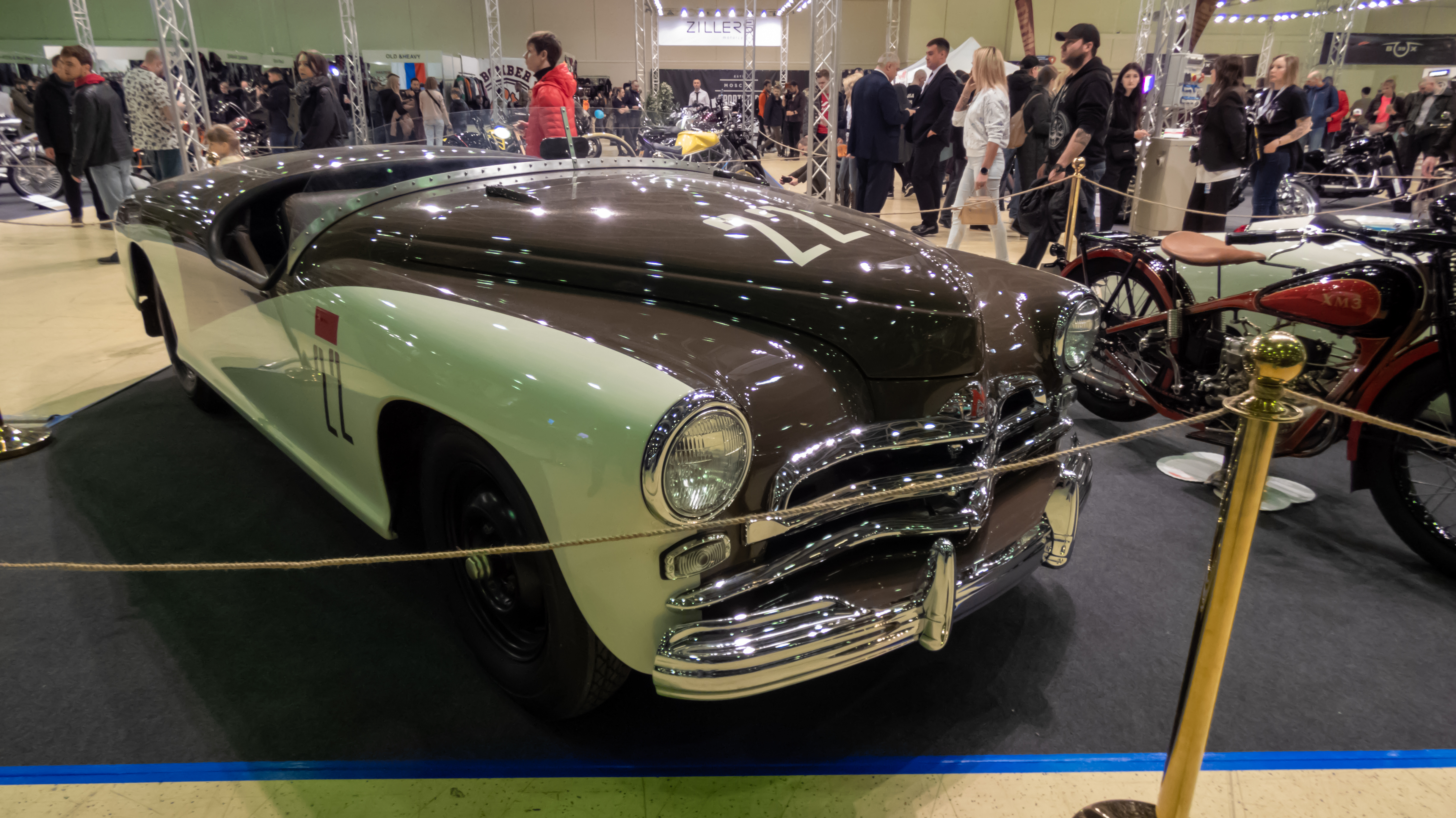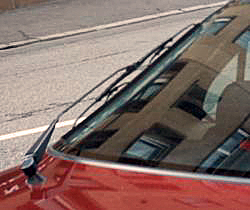|
GAZ-M20 Pobeda
The GAZ-M20 "Pobeda" (russian: ГАЗ-М20 Победа; ''победа'' means ''victory'') was a passenger car produced in the Soviet Union by GAZ from 1946 until 1958. It was also licensed to the Polish Passenger Automobile Factory and produced as the FSO Warszawa. Although usually known as the GAZ-M20, an original car's designation at that time was just M-20: M for "Molotovets" (the GAZ factory was named after Vyacheslav Molotov). History The first sketches of similar-looking cars were completed by Valentin Brodsky in 1938 and by Vladimir Aryamov in 1940, which revealed a growing tendency towards streamlined car design in the Soviet Union. Aryamov's two-door coupe GAZ-11-80, designed in 1940, greatly resembled the later Pobeda and was in many ways identical to it. However, after the German invasion of 1941 military priorities delayed the work on the new car and the factory was switched to military production. The first Pobeda was developed in the Soviet Union under chief ... [...More Info...] [...Related Items...] OR: [Wikipedia] [Google] [Baidu] |
Nizhny Novgorod
Nizhny Novgorod ( ; rus, links=no, Нижний Новгород, a=Ru-Nizhny Novgorod.ogg, p=ˈnʲiʐnʲɪj ˈnovɡərət ), colloquially shortened to Nizhny, from the 13th to the 17th century Novgorod of the Lower Land, formerly known as Gorky (, ; 1932–1990), is the administrative centre of Nizhny Novgorod Oblast and the Volga Federal District. The city is located at the confluence of the Oka and the Volga rivers in Central Russia, with a population of over 1.2 million residents, up to roughly 1.7 million residents in the urban agglomeration. Nizhny Novgorod is the sixth-largest city in Russia, the second-most populous city on the Volga, as well as the Volga Federal District. It is an important economic, transportation, scientific, educational and cultural center in Russia and the vast Volga-Vyatka economic region, and is the main center of river tourism in Russia. In the historic part of the city there are many universities, theaters, museums and churches. The city ... [...More Info...] [...Related Items...] OR: [Wikipedia] [Google] [Baidu] |
Operation Barbarossa
Operation Barbarossa (german: link=no, Unternehmen Barbarossa; ) was the invasion of the Soviet Union by Nazi Germany and many of its Axis allies, starting on Sunday, 22 June 1941, during the Second World War. The operation, code-named after Frederick Barbarossa ("red beard"), a 12th-century Holy Roman emperor and German king, put into action Nazi Germany's ideological goal of conquering the western Soviet Union to repopulate it with Germans. The German aimed to use some of the conquered people as forced labour for the Axis war effort while acquiring the oil reserves of the Caucasus as well as the agricultural resources of various Soviet territories. Their ultimate goal was to create more (living space) for Germany, and the eventual extermination of the indigenous Slavic peoples by mass deportation to Siberia, Germanisation, enslavement, and genocide. In the two years leading up to the invasion, Nazi Germany and the Soviet Union signed political and economic pacts fo ... [...More Info...] [...Related Items...] OR: [Wikipedia] [Google] [Baidu] |
AM Radio
AM broadcasting is radio broadcasting using amplitude modulation (AM) transmissions. It was the first method developed for making audio radio transmissions, and is still used worldwide, primarily for medium wave (also known as "AM band") transmissions, but also on the longwave and shortwave radio bands. The earliest experimental AM transmissions began in the early 1900s. However, widespread AM broadcasting was not established until the 1920s, following the development of vacuum tube receivers and transmitters. AM radio remained the dominant method of broadcasting for the next 30 years, a period called the "Golden Age of Radio", until television broadcasting became widespread in the 1950s and received most of the programming previously carried by radio. Subsequently, AM radio's audiences have also greatly shrunk due to competition from FM ( frequency modulation) radio, Digital Audio Broadcasting (DAB), satellite radio, HD (digital) radio, Internet radio, music streaming ser ... [...More Info...] [...Related Items...] OR: [Wikipedia] [Google] [Baidu] |
Windshield Wiper
A windscreen wiper, windshield wiper, wiper blade (American English), or simply wiper, is a device used to remove rain, snow, ice, washer fluid, water, or debris from a vehicle's front window. Almost all motor vehicles, including cars, trucks, buses, train locomotives, and watercraft with a cabin—and some aircraft—are equipped with one or more such wipers, which are usually a legal requirement. A wiper generally consists of a metal arm; one end pivots, and the other end has a long rubber blade attached to it. The arm is powered by a motor, often an electric motor, although pneumatic power is also used for some vehicles. The blade is swung back and forth over the glass, pushing water, other precipitation, or any other impediments to visibility from its surface. The speed is usually adjustable on vehicles made after 1969, with several continuous rates and often one or more ''intermittent'' settings. Most personal automobiles use two synchronized ''radial''-type arms, ... [...More Info...] [...Related Items...] OR: [Wikipedia] [Google] [Baidu] |
October Revolution
The October Revolution,. officially known as the Great October Socialist Revolution. in the Soviet Union, also known as the Bolshevik Revolution, was a revolution in Russia led by the Bolshevik Party of Vladimir Lenin that was a key moment in the larger Russian Revolution of 1917–1923. It was the second revolutionary change of government in Russia in 1917. It took place through an armed insurrection in Petrograd (now Saint Petersburg) on . It was the precipitating event of the Russian Civil War. The October Revolution followed and capitalized on the February Revolution earlier that year, which had overthrown the Tsarist autocracy, resulting in a liberal provisional government. The provisional government had taken power after being proclaimed by Grand Duke Michael, Tsar Nicholas II's younger brother, who declined to take power after the Tsar stepped down. During this time, urban workers began to organize into councils ( soviets) wherein revolutionaries criticized t ... [...More Info...] [...Related Items...] OR: [Wikipedia] [Google] [Baidu] |
Ponton (automobile)
Ponton or pontoon styling is an automotive design genre that spanned roughly from the 1930s-1960s, when pontoon-like bodywork enclosed the full width and uninterrupted length of a car body — eliminating previously distinct running boards and articulated fenders. The integrated fenders of an automobile with ponton styling may also be called ''Pontoon fenders,'' and the overall trend may also be known as ''envelope styling.'' Now largely archaic, the term ''Ponton'' describes the markedly bulbous, slab-sided configuration of postwar European cars, including those of Mercedes-Benz, Opel, Auto Union, DKW, Borgward, Lancia, Fiat, Rover, Renault, and Volvo—as well as similar designs from North America and Japan, sometimes — in its most exaggerated usage — called the "bathtub" look in the U.S. The term derives from the French and German word ''ponton'', meaning 'pontoon'. The Langenscheidt German–English dictionary defines ''Pontonkarrosserie'' as "all-envelop ... [...More Info...] [...Related Items...] OR: [Wikipedia] [Google] [Baidu] |
Moskvitch 400-420
The Moskvitch 400-420 is a car that was introduced in 1947 by the Soviet manufacturer Moskvitch. Background In 1940 and 1941 500 units of the KIM 10-50, the first Soviet compact car, were produced. It was inspired by the similar-sized four-door Ford Prefect and, despite its low price, equipped with such features as a mechanical clock and indicators of the level of oil and the temperature of water in the radiator. However, national priorities changed with the German invasion in summer 1941, and production of the car was halted and not resumed after the war. At war's end, the Soviet Union deemed the plans and tooling for the 1939 Opel Kadett K38 to be part of the war reparations package, since the tooling in the Rüsselsheim factory was largely intact; residents dismantled the Kadett production tooling and loaded fifty-six freight carsThompson, p.76. bound for Moscow and the newly built "Stalin Factory" (ZIS). However, according to recent Russian sources, the Kadett plans and ... [...More Info...] [...Related Items...] OR: [Wikipedia] [Google] [Baidu] |
Rüsselsheim Am Main
Rüsselsheim am Main is the largest city in the Groß-Gerau district in the Rhein-Main region of Germany. It is one of seven special status cities (implementing several functions that counties normally provide) in Hessen and is located on the Main, between Frankfurt and Mainz, only a few kilometres from its mouth in Mainz. The suburbs of Bauschheim and Königstädten are included in Rüsselsheim. Rüsselsheim has attained international recognition through the presence of the German car company Opel. History Rüsselsheim's foundation goes back to a Frankish colony in the first half of the 5th century. The first written mention of "Rucilesheim", or "the house of Rucile", is in an inventory of royal hunting rights around the year 840. Rüsselsheim emerged from a settlement of the Count of Katzenelnbogen. Over time, the name of the city evolved from Rucilesheim to the current Rüsselsheim: *764/5 Rucile(n)sheim *before 1130 Ruozcelenesheim *1336 Ruzelnsheim *1275 Ruozelsheim *1640 ... [...More Info...] [...Related Items...] OR: [Wikipedia] [Google] [Baidu] |
Opel Kapitän
The Opel Kapitän is a luxury car made in several different generations by the German car manufacturer Opel from 1938 until 1970. Kapitän (1938–1940) The Kapitän was the last new Opel model to appear before the outbreak of the Second World War, developed during 1938 and launched in the spring of 1939 at the Geneva motor show. Production began in November 1938. The first Kapitän was available in many different body styles, the most popular one being the 4-door saloon. 2-door coupé cabriolets were also built. The pre-war Kapitän featured a unitary body, an innovative feature for its time; it was studied by the Soviet engineers and heavily influenced the design of the GAZ-M20 Pobeda. The Kapitän inherited its 2.5-litre engine from its predecessor: in this application a maximum speed of 118 km/h (73 mph) was reported. Civilian automobile production by Opel ceased in the Fall / Autumn of 1940, by which time 25,371 Kapitäns had been produced: a further three ... [...More Info...] [...Related Items...] OR: [Wikipedia] [Google] [Baidu] |
Vehicle Frame
A vehicle frame, also historically known as its ''chassis'', is the main supporting structure of a motor vehicle to which all other components are attached, comparable to the skeleton of an organism. Until the 1930s, virtually every car had a structural frame separate from its body. This construction design is known as '' body-on-frame''. By the 1960s, unibody construction in passenger cars had become common, and the trend to unibody for passenger cars continued over the ensuing decades. Nearly all trucks, buses, and most pickups continue to use a separate frame as their chassis. Functions The main functions of a frame in a motor vehicle are: # To support the vehicle's mechanical components and body # To deal with static and dynamic loads, without undue deflection or distortion. :These include: ::*Weight of the body, passengers, and cargo loads. ::*Vertical and torsional twisting transmitted by going over uneven surfaces. ::*Transverse lateral forces caused by road condi ... [...More Info...] [...Related Items...] OR: [Wikipedia] [Google] [Baidu] |
Suspension (vehicle)
Suspension is the system of tires, tire air, springs, shock absorbers and linkages that connects a vehicle to its wheels and allows relative motion between the two. Suspension systems must support both road holding/handling and ride quality, which are at odds with each other. The tuning of suspensions involves finding the right compromise. It is important for the suspension to keep the road wheel in contact with the road surface as much as possible, because all the road or ground forces acting on the vehicle do so through the contact patches of the tires. The suspension also protects the vehicle itself and any cargo or luggage from damage and wear. The design of front and rear suspension of a car may be different. History An early form of suspension on ox-drawn carts had the platform swing on iron chains attached to the wheeled frame of the carriage. This system remained the basis for most suspension systems until the turn of the 19th century, although the iron cha ... [...More Info...] [...Related Items...] OR: [Wikipedia] [Google] [Baidu] |


.jpg)






.png)